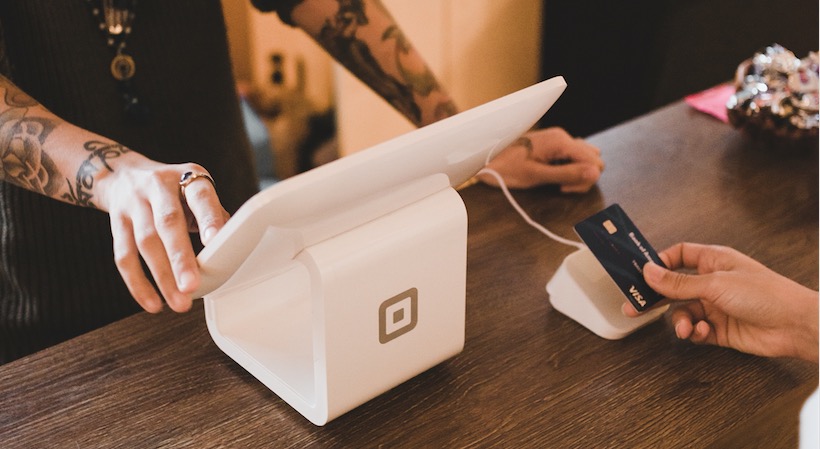When you’re starting a business, one of the biggest concerns is, “How do I accept payment?” Sure, some businesses do just fine on a cash-only basis, but being able to accept credit cards could be a game-changer for your business, especially in 2019.
It’s even better when you can accept credit cards without needing a lot of special equipment. Enter the mobile card reader! With just a handheld device and a smartphone, the savvy entrepreneur can get paid pretty much anywhere.
How does a mobile card reader work?
Mobile card readers are simple. The reader connects to a smartphone or tablet on which a mobile point of sale app (mPOS) has been installed. The device acts as the actual cash register, storing item inventory, product descriptions, prices, tax information and even discounts. The mPOS can send digital receipts via SMS (text message) or email.
A mPOS app and mobile card reader has a much smaller footprint than a traditional point of sale device or cash register. As long as your phone or tablet has a battery charge and an internet connection, you can swipe, dip, or even tap a card and get paid on the spot.
Related: Top 5 Payment Acceptance Solutions for Small Business
Why your startup needs a mobile card reader
There are plenty of advantages to having a mobile card reader for your business, and only some of them involve mobility.
A good mPOS app offers a wealth of additional features, such as:
Your customers will never miss a purchase (and you never miss making a sale)
Americans who carry cash with them carry, on average, about $25, according to research by Capital One. But some demographics (namely millennials) are less likely to carry any cash at all.
That presents a problem for you as a business owner; either you miss out on a sale because you can’t accept cards, or you have to send customers off in search of an ATM (and they may never come back). Having a card reader on hand means you can capture all those impulse purchases, no matter where they occur.
Sell to anyone, anywhere
Most brick-and-mortar shops rely on bulky equipment and POS terminals to take credit cards. But all you really need is a mobile card reader and a cell phone or tablet. Some mobile POS apps and card readers can even work in offline mode, making internet access more of a luxury than a necessity. Plus, most mobile apps can work as lightweight registers in physical storefronts if you want them to.
Get extra software to run your business
Mobile card readers need a mobile POS app. But these apps are capable of a lot more than punching in a sale amount. A good mPOS app can help you manage inventory, generate sales reports and even send invoices or sync with your online sales. However, the quality of these additional tools does vary. Make sure that these extra features are functional enough to suit your startup’s needs.
Minimal investment required to get started
Most mobile POS apps are available on a no-contract, pay-as-you-go basis. At most, you might pay a small monthly fee for the software, but you’re not locked into a long-term contract or obligated to reach any monthly minimums. Even if you don’t make many sales, you won’t be losing money with a mobile processing setup.
What to look for in a mobile card reader
On the surface, it might seem like all card readers are similar. But when you’re comparing your options, you need to look at several factors, including the mobile app the hardware pairs with.
Card reader cost
Mobile card readers can cost anywhere from $0 to $100 or more, depending on where you purchase from.
Free readers can be really enticing, but the cost shouldn’t be your only consideration. It wouldn’t be unreasonable to pay as little as $25 up to $50 for a good card reader, especially if the accompanying mobile app offers a lot of value.
Processing fees
Most mobile processing systems have flat rate pricing and pay-as-you-go agreements, which means you’ll have predictable costs and that any fees are deducted before you get your funds.
Generally, these processing rates are in the ballpark of 2.65 percent to 2.75 percent per transaction. A 0.10 percent difference in fees means you’d need to process thousands of dollars in a single month to actually see any sort of substantial savings, so ultimately they’re all fairly comparable. But other processors do offer different rates — and it’s up to you to make sure these pricing plans work for your business.
EMV (chip card) support
In 2015, the card associations and banks agreed that merchants would start to bear the liability for processing fraudulent swipe transactions that could have been prevented with an EMV-capable reader.
While you can still find these basic magstripe readers, most processors now offer a card reader that supports swipe and chip transactions. Some also add NFC support so you can accept contactless payments from Apple Pay, Android Pay and other “Pay” apps.
Card reader design
Look for a card reader that has a Bluetooth connection to your phone or tablet, rather than using the headphone jack or Lightning port (for Apple devices).
Beyond that, you should also consider how you plan to use the reader: Do you need a dock so customers can insert their own cards? Would you rather mount it into a clip?
Most readers are designed to get (at minimum) a full eight hours of use before recharging, so battery life shouldn’t be much of a concern.
The mobile card readers every entrepreneur should consider
So, who offers the best mobile card reader (and by extension, the best mobile processing app)?
There are a lot of options out there — many merchant account providers will offer a mobile app in addition to their core processing options for brick-and-mortar locations. However, if you do have a merchant account, you’re by no means obligated to use the app your account provider offers. A standalone, pay-as-you-go option gives you the freedom and flexibility to go wherever.
Square
Square has earned its place at the top of nearly every list of mobile card readers for a few reasons, including its affordable hardware, the feature-rich mPOS app, and the way the company has democratized payments and software for small businesses.
Nearly any entrepreneur can sign up for an account with Square and start accepting payments almost right away.
Square offers a free magstripe reader (connecting via headphone jack or lightning port) to new customers. Its EMV-capable reader, the Contactless + Chip reader, is a bit more expensive, but financing is available for credit-worthy merchants.
In addition, the mobile app offers advanced inventory features, sales tax settings, discounts, multiple user logins and advanced reporting. Square does offer its customers a free website via Weebly, plus the ability to send invoices online or via the mobile app.
Square fast facts
- Free magstripe reader
- $49 Contactless + Chip Reader
- 2.75 percent per swiped, dipped or tapped transaction
- Invoicing, free webstore included
PayPal Here
PayPal is probably best known for its P2P payments and mobile wallet features, but PayPal now offers an extensive suite of business features for merchants. These features encompass both e-commerce and in-person sales.
PayPal has stopped offering a free magstripe card reader the way Square does. Instead, its Chip and Swipe Reader goes for a very reasonable $24.99, and even includes a clip for mounting it to a phone case.
The PayPal Here mobile POS app isn’t quite as feature-rich as Square, but it still offers solid inventory tools, multi-user support, sales tax collection and reporting tools.
For charities, PayPal supports donation buttons with automatic recurring donations at no additional charge.
PayPal fast facts
- $24.99 Chip and Swipe Reader
- 2.7 percent per swiped, dipped or tapped transaction
- Invoicing, “buy” buttons included
Shopify Lite
Shopify started as an e-commerce platform and is still a giant of the industry. However, these days, the company also offers its own mobile POS app and pared down features for businesses that want to test the waters of online sales.
The Shopify Lite plan, at $9/month, is a great way to experiment with the Shopify platform and scale up e-commerce as an important part of your business strategy.
Shopify’s Chip and Swipe reader is free to new merchants on any plan (including Shopify Lite) and comes with a free reader. However, you need to be on the higher service plans to access some of the advanced features within the POS app, such as other hardware integrations.
The Shopify POS app offers advanced inventory, geo-detecting sales tax settings and even support for invoices. On the e-commerce side, you can create “buy” buttons as well as sell through both Facebook and Instagram.
Upgrading to your own Shopify store is easy, painless and gives you even more flexibility to sell in person and online.
Shopify Lite fast facts
- Free Chip and Swipe Reader
- $9/monthly fee
- 2.7 percent per swiped, dipped or tapped transaction
- Invoicing, buy buttons, and Facebook/Instagram sales included
Sign Up: Receive the StartupNation newsletter!
Which mobile card reader is right for you?
Simplicity is key when it comes to mobile processing. But you shouldn’t be swayed simply by the amount of work you won’t have to do to get set up. You should look for a card reader that suits the way you do business, and also think ahead: If everything goes well, where do you want to take your business next?
While you can narrow down the options to a few top choices, there really isn’t a “one size fits all” answer to choosing a mobile card reader.
Every business is different, and you need to really focus on what features will be most beneficial to you and your growing business.






